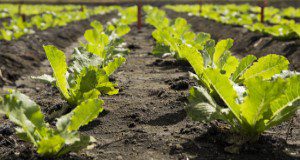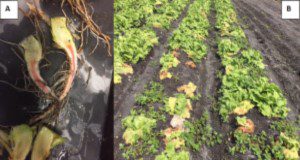Lettuce Downy Mildew (LDM), caused by the oomycete Bremia lactucae, is the most important disease of lettuce worldwide. LDM has a direct effect on both yield quantity and quality because it may infect lettuce at any growth stage, affecting the marketable portion of the crop. This new 6-page publication of the UF/IFAS Horticultural Sciences Department introduces the LDM disease in Florida lettuce and available control methods and strategies. This publication also introduces the work on LDM in the UF/IFAS Lettuce Breeding Program, which was created to release cultivars adapted to Florida conditions. Written by Lis Rodrigues-Porto, Richard N. Raid, and Germán V. Sandoya.
https://edis.ifas.ufl.edu/hs1403
Tag: Lettuce Pest Management
Fusarium Wilt: A New Threat to Florida Lettuce Production
Fusarium wilt of lettuce is a disease caused by the fungus Fusarium oxysporum f.sp. lactucae. The disease is present in all lettuce production areas worldwide. Recently this disease has been identified in Florida in localized fields. This new 4-page publication of the UF/IFAS Horticultural Sciences Department presents information about the disease, symptoms, and control measures useful to lettuce growers in Florida. Following these recommendations may help to avoid the spread of this fungus in muck soils at the Everglades Agricultural Area (EAA), where 90% of the lettuce in Florida is planted. Written by Germán V. Sandoya, Jesse J. Murray, Richard N. Raid, and Christian F. Miller.
https://edis.ifas.ufl.edu/hs1385
Lettuce Cultivars for Insect Resistance in Southern Florida (HS1196/HS1196)
 Florida’s subtropical climate facilitates lettuce production from fall through spring, but the warm, moist conditions are also favorable for insect proliferation and damage. Information about current cultivar response to common insect pests in Florida is limited, so UF/IFAS researchers conducted a study to evaluate cultivar response to insect infestation under field conditions and to identify resistance useful for integrated pest management. This 4-page fact sheet was written by Huangjun Lu, Alan L. Wright, and David Sui, and published by the UF Department of Horticultural Sciences, February 2012.
Florida’s subtropical climate facilitates lettuce production from fall through spring, but the warm, moist conditions are also favorable for insect proliferation and damage. Information about current cultivar response to common insect pests in Florida is limited, so UF/IFAS researchers conducted a study to evaluate cultivar response to insect infestation under field conditions and to identify resistance useful for integrated pest management. This 4-page fact sheet was written by Huangjun Lu, Alan L. Wright, and David Sui, and published by the UF Department of Horticultural Sciences, February 2012.
http://edis.ifas.ufl.edu/hs1196
Weeds and Epidemiology of Bacterial Leaf Spot of Lettuce in the Everglades Agricultural Area (SSAGR347/AG357)
This 2-page fact sheet briefly covers the history, symptoms, and epidemiology of this disease of lettuce. Written by D.C. Odero, and published by the UF Department of Agronomy, May 2011.
http://edis.ifas.ufl.edu/ag357

